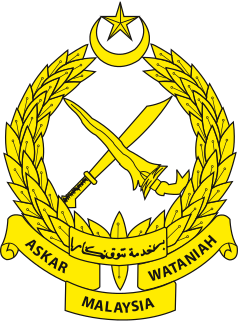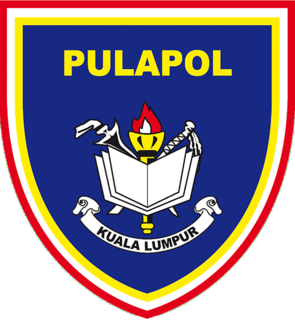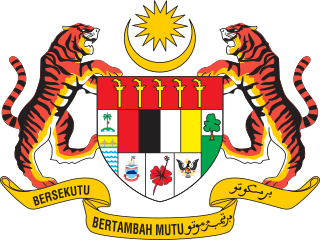Related Research Articles

The Malayan Union was a union of the Malay states and the Straits Settlements of Penang and Malacca. It was the successor to British Malaya and was conceived to unify the Malay Peninsula under a single government to simplify administration. Following opposition by the ethnic Malays, the union was reorganized as the Federation of Malaya in 1948.

Sir Frank Athelstane Swettenham was a British colonial administrator who became the first Resident general of the Federated Malay States, which brought the Malay states of Selangor, Perak, Negeri Sembilan and Pahang together under the administration of a Resident-General based in Kuala Lumpur. He served from 1 July 1896 to 4 November 1901. He was also an amateur painter, photographer and antique collector.

The Malayan Communist Party (MCP), officially known as the Communist Party of Malaya (CPM), was a political party in the Federation of Malaya and Malaysia. It was founded in 1930 and laid down its arms in 1989. It is most known for its role in the Malayan Emergency.

The Rejimen Askar Wataniah is the military reserve force of the Malaysian Army.

Malaya was gradually occupied by the Japanese between 8 December 1941 and the Allied surrender at Singapore on 16 February 1942. The Japanese remained in occupation until their surrender to the Allies in 1945. The first Japanese garrison in Malaya to lay down their arms was in Penang on 2 September 1945 aboard HMS Nelson.
This article lists important figures and events in the public affairs of British Malaya during the year 1946, together with births and deaths of prominent Malayans. Malaya remained under British Military Administration until the establishment of the Malayan Union on 1 April.

The Malaysian Police Training Centre is the oldest police academy in Malaysia and the training institute for Royal Malaysia Police. It is located at Semarak Street, Kuala Lumpur. It is the place where the police is trained under the government. Learning in Pulapol encompasses training aspect, from academic or practical. Pulapol has seven branches: Pulapol Jalan Semarak, Kuala Lumpur, Pulapol Bukit Sentosa, Rawang, Pulapol Air Hitam, Negeri Sembilan, Pulapol Segamat, Johor, Pulapol Langkawi, Kedah, Pulapol Dungun, Terengganu, Pulapol Kota Kinabalu, Sabah and Pulapol Kuching, Sarawak. The police trainees will be guaranteed to have a job and will be trained for six or nine months there.

The All-Malaya Council of Joint Action (AMCJA) was a coalition of political and civic organisations in Malaya formed to participate in the development of a constitution for post-war Malaya in preparation for independence and to oppose the Constitutional Proposals for Malaya which eventually formed the basis of the Federation of Malaya Agreement.

Kuala Lumpur is the largest city in Malaysia; it is also the nation's capital. The history of Kuala Lumpur began in the middle of the 19th century with the rise of the tin mining industry, and boomed in the early 20th century with the development of rubber plantations in Selangor. It became the capital of Selangor, later the Federated Malay States, and then Malayan Union, and finally Malaya and Malaysia.

The British Military Administration (BMA) was the interim administrator of British Malaya from August 1945, the end of World War II, to the establishment of the Malayan Union in April 1946. The BMA was under the direct command of the Supreme Allied Commander South East Asia, Lord Louis Mountbatten. The administration had the dual function of maintaining basic subsistence during the period of reoccupation, and also of imposing the state structure upon which post-war imperial power would rest.

Kesatuan Melayu Muda (KMM) was the first leftist and national political establishment in British Malaya. Founded by Ibrahim Yaacob and Ishak Haji Muhammad, KMM grew into a prominent pre-war nationalist movement, notable for its leftist political stance and willingness to use violence, a sharp break with their contemporaries in the Malay nationalist movement.
Sir Richard Olaf Winstedt, or more commonly R. O. Winstedt, was an English Orientalist and colonial administrator with expertise in British Malaya.

The Royal Malaysia Police trace their existence to the Malacca Sultanate in the 1400s and developed through administration by the Portuguese, the Dutch, modernization by the British beginning in the early 1800s, and the era of Malaysian independence.

The Royal Malaysian Customs Department, abbreviated RMC or JKDM, is the Malaysian Government agency responsible for administrating the nation's indirect tax policy, border enforcement and narcotic offences. In other words, KDRM administers seven main and 39 subsidiary laws. Apart from this, KDRM implements 18 lawsbyaws for other government agencies. KDRM is now known as JKDM when Ibrahim Jaapar took over as the leader of the department in 2009.

The General Operations Force is the light infantry arm of the Royal Malaysia Police. The General Operations Force was established in 1948 during the Malayan Emergency by the British Administration when Malaya was a colony. The police service was mobilised to the field role, primarily to engaging Communist guerrillas during the emerging Insurgency. When Malaysia was formed in 1963, this law enforcement unit was then known as the Police Field Force. The title was adopted when it dropped the previous handle widely referred to as the Jungle Squad.
Counter-terrorism in Malaysia is a series of measures implemented in Malaysia to detect and prevent terrorism as well as to minimise damages from such terrorist acts should they occur. These measures involve all levels of security services including military, police, border and infrastructure security, civil defence, medical readiness and psychological preparedness. Malaysia also participates actively in international counter-terrorism efforts. Malaysia has experienced sustained terrorism threats from 1948 until 1989, particularly from the Malayan Communist Party. The Internal Security Act 1960 (repealed 2012, replaced with Security Offences Act 2012 was enacted to prevent terrorism in Malaysia.

The Malayan People's Anti-Japanese Army was a paramilitary group that was active during the Japanese occupation of Malaya from 1942 to 1945. Composed mainly of ethnic Chinese guerrilla fighters, the MPAJA was the biggest anti-Japanese resistance group in Malaya. Founded on 18 December 1941 during the Japanese invasion of Malaya, the MPAJA was conceived as a part of a combined effort by the Malayan Communist Party (MCP), British colonial government, and various anti-Japanese groups to resist the Japanese occupation of Malayan territory. Although the MPAJA and the MCP were officially different organisations, many saw the MPAJA as a de facto armed wing of the MCP due to its leadership being staffed by mostly ethnic Chinese communists. Many of the ex-guerrillas of the MPAJA would later join the MCP in its open conflict with the BMA during the Malayan Emergency.
This article lists important figures and events in the public affairs of British Malaya during the year 1945, together with births and deaths of prominent Malayans. Malaya remained under Japanese occupation until September, when British Military Administration was installed.

The Inspector-General of Police, also known as the Chief of Police, is the highest-ranking police officer of the Royal Malaysian Police. Assisted by the Deputy Inspector-General of Police, he reports to the Minister of Home Affairs. The IGP is based at Bukit Aman, Kuala Lumpur which is the Headquarters of the RMP.
The Elite Forces include both a specially trained unit and a small percentage of personnel from a specific Malaysian military branch, law enforcement or government agency. In Malaysia, the term 'Elite Forces' is widely used by uniformed services for special forces, special operations forces and specially trained units. Regular personnel must undertake specialized training to be able to join the units of the 'Elite Forces'. These 'Elite Forces' are denoted by different beret colours, shoulder tabs, unit patches, skill badges and uniforms.
References
- ↑ Civil Affairs Police Force (Malay language)
- ↑ Malayan Union Police Force (Malay language)
